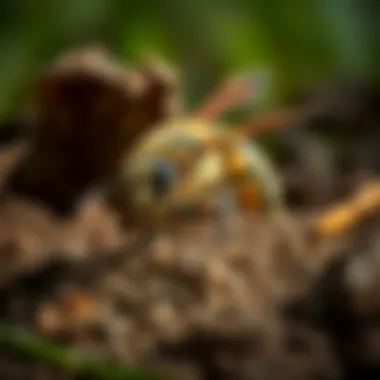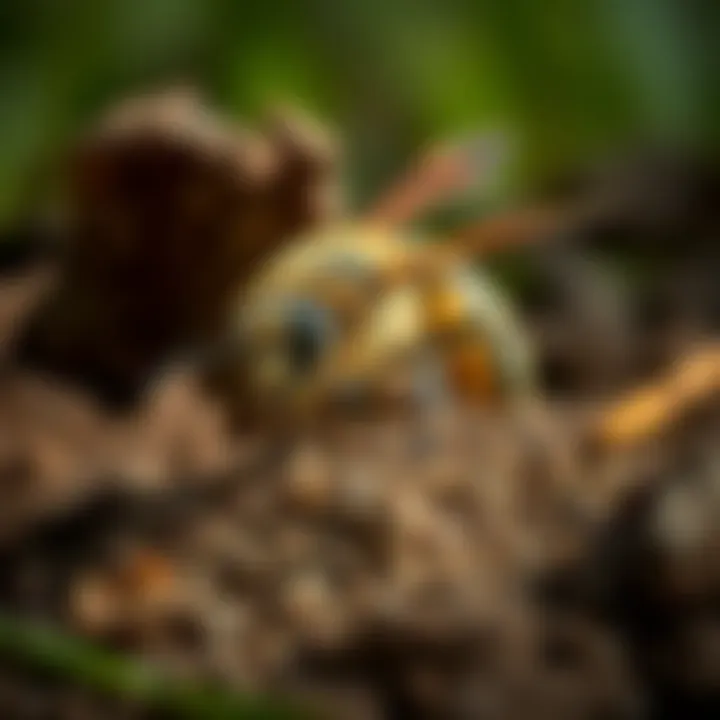Ground Bees: Ecology, Characteristics, and Conservation


Intro
Ground bees often flutter under the radar despite their significant role in our ecosystems. These small, burrowing creatures are crucial for pollination, supporting the growth of various plant species. One might even say they are the unsung heroes of our gardens and forests. This article takes a closer look at the world of ground bees, shedding light on their life cycle, unique characteristics, and ecological importance. Furthermore, it highlights the pressing conservation challenges these insects face, alongside practical measures we can implement to ensure their survival. As we uncover the intricacies of ground bees, we come to appreciate their contribution to sustaining biodiversity and the health of our forest ecosystems.
Understanding Forestry Practices
Forestry practices play a pivotal role in shaping the habitats of ground bees. By understanding these practices, we can better protect the ecosystems in which these bees thrive.
Types of Forestry Practices
There are several types of forestry practices that influence the survival and health of ground bee populations:
- Conventional Forestry: Generally involves clear-cutting and monoculture planting, which can diminish biodiversity and soil health, thus limiting habitats for ground bees.
- Sustainable Forestry: This method focuses on maintaining biodiversity and ecosystem functionality. It promotes varied plant populations that support a multitude of species, including ground bees.
- Agroforestry: Combining agricultural crops with trees creates a rich habitat. This not only benefits crops but also provides for ground bees, as diverse plants offer nectar and pollen sources.
Historical Context
Historically, forestry practices have strived for maximum yield, often leading to habitat loss. Many ground bee species were pushed to the sidelines, unable to adapt to rapid environmental changes. In recent decades, however, there's been a shift towards more sustainable practices, aimed at preserving biodiversity. Learning from history is crucial for shaping future conservation efforts.
The decline of many bee species highlights the interconnectedness of forestry and ecology. Protecting ground bees demands a deeper understanding of forestry practices and their ecological impact.
Principles of Woodland Stewardship
To foster healthy environments for ground bees, effective woodland stewardship is essential. This principle encompasses the responsible management of forest resources to ensure longevity and resilience.
Conservation Techniques
Several techniques promote conservation in forestry:
- Selective Logging: Rather than clear-cutting, this practice involves removing only certain trees, allowing the forest's structure and biodiversity to remain intact.
- Creating Habitats: Leaving fallen trees and maintaining native vegetation can provide necessary habitats for ground bees.
Managing Forest Resources
An integral part of woodland stewardship is managing resources wisely:
- Monitoring Pollinator Populations: Regularly assessing the health and numbers of ground bee populations helps guide effective conservation measures.
- Community Engagement: Encouraging local communities to participate in conservation efforts ensures a broader impact.
Sustainable Forest Management
Sustainable forest management is essential for protecting ground bees and their habitats. This approach involves strategies aimed at balancing ecological health with economic interests.
Certification Standards
Certifications like Forest Stewardship Council (FSC) and Sustainable Forestry Initiative (SFI) ensure that forestry practices meet specific environmental standards. Companies adhering to these certifications can guarantee their practices contribute to biodiversity conservation and the well-being of species like ground bees.
Economic Benefits of Sustainability
Investing in sustainable practices does more than protect the environment; it also provides economic advantages:
- Ecosystem Services: Healthy ecosystems contribute to services like pollination, which are pivotal for crop production and, ultimately, food security.
- Attracting Tourism: Well-managed forests become habitats for diverse wildlife, drawing visitors and stimulating local economies.
Prolusion to Ground Bees
The exploration of ground bees holds significant weight in understanding ecological systems. These creatures are often tucked away from common dialogue, overshadowed by more prominent pollinators like honey bees. However, ground bees are a crucial cog in the wheel of ecosystem health and productivity. By digging deeper into their characteristics and behaviors, we can appreciate their role in pollination and biodiversity.
Ground bees are primarily solitary insects, nesting in the soil rather than in hives. This characteristic differentiates them from their social counterparts and contributes to their unique life cycle and ecological interactions. Their solitary nature allows them to exploit a variety of niches and play diverse roles within habitats.
The benefits of understanding ground bees are manifold. For one, they influence plant reproduction significantly, fostering the growth of various flora crucial for other wildlife. Their habits offer crucial insights into the health of ecosystems, as their presence can indicate soil quality and habitat richness.
Considerations regarding the study of ground bees stem from their declining populations, often attributed to habitat loss and pesticide use. Bringing attention to such matters can help anyone interested in environmental science or conservation understand the urgency of protective measures. It’s not just about saving a bee; it’s about safeguarding the intricate web of life they support.
Defining Ground Bees
Ground bees are members of the family Andrenidae, among others, and they encompass a wide range of species. They are predominantly characterized by their ground-nesting habits, which set them apart from other bees. Rather than building elaborate hives, these bees prefer to create simple burrows in the soil, which they use for breeding and storing food.
Their appearance varies greatly, with some sporting bright colors while others blend in with their surroundings. Most ground bees are small to medium-sized, typically measuring between 5 to 15 millimeters in length.
"Ground bees are perhaps the unsung heroes of pollination, quietly working behind the scenes to sustain ecosystems."


Taxonomy and Diversity
The taxonomy of ground bees reveals a rich tapestry of diversity that deserves attention. They are categorized into numerous genera, with each genus hosting distinct species. For instance, the genus Andrena is one of the most extensive groups comprising over 1,000 species found across the globe. Such diversity offers critical insights into ecological adaptations and evolutionary processes within insect populations.
Ground bees exhibit a variety of traits adapted to specific environments. For example, some species are specialized pollinators for certain plants, demonstrating a tight relationship with local flora. Such specialization can be vital for the survival of both the bees and the plants they pollinate, reinforcing their ecological interdependence.
In summary, the taxonomy and diversity among ground bees highlight their importance within the broader ecological narrative. Recognizing the numerous species and their unique adaptations can pave the way for more effective conservation strategies. Understanding this complexity helps in crafting targeted measures for their protection, ensuring that they continue to fulfill their essential role in our ecosystems.
Further Reading
- Wikipedia - Ground Bees
- Britannica - Bees
- National Wildlife Federation - Pollinators
- USDA - Pollinator Protection
Behavioral Characteristics of Ground Bees
Understanding the behavioral characteristics of ground bees is pivotal for grasping their role in ecosystems. These behaviors are not just mere activities; they encapsulate survival strategies that have evolved over millions of years. Behavioral patterns reveal much about how these insects interact with their environment, which subsequently influences pollination and biodiversity. By examining their nesting habits, foraging patterns, and life cycle stages, we get a comprehensive glimpse into their world, which can inform conservation efforts and enhance our understanding of their ecological importance.
Nesting Habits
Ground bees primarily dig their nests directly into the soil, which sets them apart from their more well-known relatives, the honey bees. The choice of nesting sites often speaks volumes about their behavior and habitat preferences. These bees typically favor sandy or loose soils that allow for easy tunneling. Oftentimes, they will seek out locations with direct sunlight, as the warmth helps in the incubation of their eggs.
- Nest Architecture: Unlike the elaborate hives of honey bees, ground bees typically construct simple burrows, sometimes featuring several chambers for brood rearing.
- Social Structures: Most ground bees are solitary, yet a few species may nest in close proximity, leveraging communal traits to enhance survival.
- Environmental Factors: Nesting habits vary significantly with climate and local flora. For instance, certain species gravitate towards urban environments, where they capitalize on garden flowers, while others remain tied to wild habitats.
Such nesting habits influence reproductive cycles and can have far-reaching implications on local ecosystems.
Foraging Patterns
Foraging in ground bees isn't just about gathering pollen and nectar; it engages them in a complex dance between survival, reproduction, and environmental health.
- Flower Preferences: Ground bees have distinct preferences for certain flowers based on color, scent, and shape. For example, they are frequently found pollinating native plants, which bodes well for local biodiversity.
- Timing: The foraging activity often aligns with specific times of the day. Ground bees are generally more active during warm, sunny hours, which ties back into their nesting habits. They work tirelessly but strategically, managing their energy efficiently to maximize reproductive success.
- Pollination Efficiency: As they move from flower to flower, ground bees exhibit a phenomenon known as flower constancy. This means they tend to stick to one type of flower per trip, which boosts pollination efficiency.
These foraging patterns can hugely affect plant reproduction and, by extension, the entire ecosystem.
Life Cycle Stages
The life cycle of ground bees is fascinatingly intricate, marked by various stages that occur in the soil.
- Egg Stage: The female usually lays eggs in individual chambers of the nest, often accompanied by a provision of pollen and nectar to nourish the larvae once they hatch.
- Larval Stage: After a few days, the eggs hatch into larvae and feed on the provided provisions. This stage can last several weeks depending on environmental conditions.
- Pupal Stage: Following the larval phase, the larvae pupate within the protective nest. The timing of this stage can vary; some may overwinter in this form, emerging when conditions are favorable.
- Adult Stage: Finally, the adult bees emerge, ready to begin the cycle anew. This emergence period often coincides with the blooming of certain plants, demonstrating a remarkable synchronicity with their surroundings.
Understanding these life stages enables more effective conservation strategies, particularly in mitigating threats to their habitats.
In summary, ground bees exhibit a plethora of behavioral characteristics that play significant roles in their lives and the ecosystems they support. Gaining insights into their nesting habits, foraging behaviors, and life cycles not only enriches our comprehension of these pollinators, but also emphasizes the urgent need for conservation strategies to protect them.
Ecological Significance of Ground Bees
Ground bees might often be glanced at, but their impact on ecosystems is monumental. Understanding their ecological significance is vital, not just for academia but for shaping effective conservation strategies. Their contributions primarily fall into three central areas: pollination, biodiversity, and food systems. Each of these aspects illustrates the intricate relationship ground bees have with their ecosystems and highlights the need for targeted conservation efforts.
Role in Pollination
Ground bees are often unsung heroes in the world of pollination. Unlike honeybees, which are social creatures, ground bees lead solitary lives. This independence offers them unique advantages. Ground bees can venture into habitats where other pollinators may not operate effectively. For instance, they often visit blossoms that are low to the ground, such as clover and dandelions, which might be overlooked by larger pollinators. Their specialized foraging behavior means they are crucial to the pollination processes of numerous flowering plants.
- Efficiency and Variety: Ground bees can pollinate a high number of flowers in a single trip. They’re quick and agile, navigating flowers with ease, which increases the likelihood of pollen transfer.
- Adaptation: These bees are incredibly adaptive. For example, different species prefer various types of flowers based on their morphology and feeding habits. This diversity accentuates their value as pollinators across different habitats.
From gardens to agricultural lands, ground bees are vital for maintaining the health of many ecosystems. Their role in pollination affects not just the plants, but the entire food web relying on these plants for energy.
Contribution to Biodiversity
The presence of ground bees contributes significantly to ecosystem biodiversity. By pollinating a range of plants, they support various species within an environment. Plants attract different creatures, from insects to birds, creating a complex web of life. Biodiversity is crucial for resilience in ecosystems. When species are diverse, the ecosystem can better withstand changes and stressors such as climate change or disease.
- Habitat Creation: Ground bees also contribute to the formation of habitats for other organisms. As they pollinate plants, they assist in the growth of both flora and fauna, creating balanced ecosystems.
- Genetic Diversity: Their pollination activities promote genetic diversity among plants. This genetic pool is essential for adapting to new challenges and threats, ensuring long-term survival.
Impact on Food Systems
The influence of ground bees extends beyond the ecological envelope to directly affecting human food systems. Many crops and fruits that form staples in diets rely on pollination from ground bees. Without them, the yield of these plants would diminish dramatically, leading to potential food security issues.
- Crop Pollination: Studies have shown that crops like apples, blueberries, and squash significantly benefit from ground bee activity. As a result, many farmers who utilize organic practices might find it valuable to encourage these populations.
- Ecosystem Services: Ground bees support services that many farmers and cultivators may not even realize they depend on. These unappreciated contributors ensure farms can sustain themselves and provide for local and global markets. Moreover, sustainable farming practices that nurture ground bee populations can lead to higher quality produce and better yields.
"Ground bees play an unsung yet vital role in thriving ecosystems and ur food security. Losing them would have a ripple effect, threatening both biodiversity and food production."


Overall, recognizing the ecological significance of ground bees is critical for fostering a world where both agriculture and natural ecosystems can thrive. Their vital functions ripple through the ecosystem and the human food web, emphasizing the urgent need for conservation and support of these indispensable pollinators.
Identifying Ground Bees
Understanding the physical traits and behaviors of ground bees is crucial not only for those studying them but also for conservation efforts. By being able to identify these bees, we can appreciate their role in our ecosystems and how to protect them. This section will delve into the specific characteristics that help distinguish various ground bee species from one another, underscoring their importance within the larger ecological canvas.
Physical Characteristics
Physical features in ground bees are varied and serve different purposes, making them essential for identification.
Body Size and Coloration
Body size and coloration can drastically vary between species of ground bees. Generally, these bees are small to medium-sized, often ranging anywhere from a few millimeters to about two centimeters in length. The coloration often leans towards shades of black, yellow, or even metallic tones. For example, the Andrena genus is typically characterized by its more robust, hairy bodies which help in the efficient transport of pollen.
The variety in coloration is not merely decorative; it also serves a practical function. Darker colored bees, especially those with metallic hues, can absorb heat more efficiently. This can be advantageous in cooler microhabitats where ground bees often nest. In terms of attracting mates or warding off predators, their markings can communicate health and genetic fitness. This attribute is particularly relevant given the pressures ground bees face from habitat degradation.
Wing Structure
The wings of ground bees tell a fascinating story about their behavior and ecology. Ground bees typically have two pairs of wings, the forewings being larger than the hind ones. The structure of these wings is intricately designed for agility. When in flight, a delicate balance between wing size and strength enables these bees to navigate through tight spaces in flowers with remarkable skill.
A distinct feature of ground bee wings is venation, which varies among species. For instance, some bees exhibit a more robust venation pattern that corresponds with their high-energy flight patterns. Thus, wing structure is not just a feature but a reflection of their adaptations. The ability to remain undetectable while foraging can be essential for their survival, particularly against bird species that feed on them.
Facial Features
Facial characteristics can provide additional clues to identifying ground bees. These features include the arrangement of facial hairs, the type of mouthparts, and even the width of the face. For instance, more specialized species, like the Melissodes, often have broader faces filled with flat hairs, designed to collect pollen more effectively.
Additionally, the shape and color of the facial structures can differentiate closely related species. These differences might seem subtle but can be pivotal for entomologists and conservationists. For example, distinctive facial markings can indicate specific nesting behaviors or preferences, allowing us to tailor conservation efforts to protect their habitats better. In summary, appreciating the facial features allows practitioners to paint a clearer picture of a ground bee's ecological role.
Common Species
Ground bees are home to a rich tapestry of species that vary widely in both characteristics and habitats. Among the recognized standout species are:
- Andrena fulva
- Colletes inaequalis
- Melipona beecheii
These species not only represent different behaviors but also illustrate the variety in nesting preferences among ground bees. By recognizing these species, we can deepen our understanding and appreciation of the complexities of ground bee ecology.
Ground Bees and Human Interaction
Understanding how ground bees interact with humans is crucial for appreciating their role in our ecosystems and agriculture. Ground bees are often overlooked, yet they contribute significantly to pollination and the overall health of the environment. Their interactions with humans can vary considerably, ranging from beneficial to contentious, depending on how people perceive and engage with these vital insects.
Cultural Perceptions
Cultural attitudes toward bees often reflect broader narratives about nature and agriculture. In many societies, bees symbolize hard work and community, yet ground bees specifically tend to escape public attention. Some may fear these insects, associating them with pain due to stings. This apprehension largely stems from a lack of understanding about ground bee behavior. Unlike their more well-known honeybee cousins, ground bees seldom sting unless provoked.
Furthermore, many traditions and folklore feature bees as harbingers of prosperity. For instance, in certain Native American cultures, bees are seen as sacred, representing a connection between the Earth and the divine. The cultural significance can foster a more appreciative view, encouraging conservation efforts and greater awareness of bees' ecological roles.
The perception issues mirror a larger problem in biodiversity loss. When people view ground bees merely as pests rather than essential pollinators, they may inadvertently contribute to their decline as habitats are altered or pesticides are misused.
Bees in Agriculture
Ground bees have a vital place in agricultural systems, serving as crucial pollinators for numerous crops. Their tunneling nature allows them to access a variety of blooms that other pollinators might skip. This is particularly important for crops like squash, blueberries, and tomatoes, which rely heavily on effective pollination for optimal yield.
However, the reliance on ground bees is not without challenges. Many farmers may not realize the extent to which these insects assist in crop production. Therefore, effective outreach and education about the economic benefits of ground bees are essential. Research indicates that enhancing ground bee populations can lead to improved pollination rates and, ultimately, larger harvests.
In addition, the integration of sustainable practices can support ground bees in agricultural settings. Techniques such as reducing pesticide use, planting wildflower buffers, and providing nesting habitats can create an inviting environment for these pollinators, fostering a beneficial relationship between farmers and their ecosystem.
Ground bees are the unsung heroes of pollination. Their contributions often go unnoticed but are essential for sustaining agriculture and biodiversity.
As we look to the future, engaging with cultural perceptions and recognizing the agricultural power of ground bees can guide conservation efforts, ensuring these crucial insects maintain their role in our environment and food systems. Educating farmers and communities about their importance can bridge the gap between human activities and ground bee preservation, ultimately leading to healthier ecosystems.
Conservation of Ground Bees
The conservation of ground bees is not merely a peripheral concern; it's a cornerstone in sustaining populations of numerous plants and maintaining the ecological balance within our environments. Without effective conservation strategies, the decline of these pollinators can lead to cascading effects on the food web, biodiversity, and even agricultural productivity. Given the essential role they play in pollination, understanding the specific threats faced by ground bee populations and implementing robust conservation measures becomes a compelling necessity.
Threats to Ground Bee Populations
Ground bee populations are confronted with a suite of challenges, each distinctly contributing to their overall decline.
Habitat Loss


Habitat loss occurs when natural landscapes are altered or replaced by urban development, intensive agriculture, or other activities that strip away the native flora required by ground bees. As habitats vanish, bee populations find it increasingly difficult to locate suitable nesting sites and forage for food. Urban sprawl, particularly, has carved up once-flourishing bee populations into smaller, isolated groups, making genetic diversity a daunting concern. This fragmentation could lead to local extinctions, which puts pressure on the entire ecosystem. The beauty of this aspect lies in its immediacy. Protecting existing habitats and restoring degraded areas enables not only bees but also a multitude of other species to thrive.
Pesticide Use
Pesticide use poses a significant threat to ground bee populations. Many common agricultural chemicals are neurotoxins that interfere with navigation and foraging. When bees gather nectar or pollen from treated plants, they expose themselves to lethal doses, leading to reduced populations over time. This point resonates deeply in agricultural sectors. While pesticides can boost crop yields, their negative impact on pollinators like ground bees can result in decreased pollination service, ultimately undermining long-term agricultural sustainability. Recognizing this, promoting integrated pest management practices becomes crucial to balancing crop protection and bee health, a win-win for both farmers and ecosystems.
Climate Change
Climate change, the slow-moving giant in environmental challenges, alters habitats and affects the availability of flowers upon which ground bees depend. Changes in temperature and precipitation patterns can modify blooming periods, leading to mismatches between when plants flower and when bees are active. Such disruptions can destabilize the food supply for ground bees and other pollinators, reducing their populations. This aspect demonstrates the importance of global actions to reduce carbon footprints and combat climate change, ensuring that ecosystems remain resilient and able to adapt.
Conservation Strategies
Conservation strategies for ground bees revolve around understanding their needs and proactively addressing the challenges they face.
Creating Bee Habitats
Creating bee habitats involves the intentional design of landscapes to support native pollinators. This can be as simple as planting native flowers in home gardens or as extensive as transitioning agricultural practices to incorporate hedgerows and wildflower strips. By fostering environments that provide food and nesting opportunities, we encourage healthier and more stable bee populations. This strategy has garnered attention due to its simplicity and effectiveness, allowing individuals to make a meaningful impact without extensive investment. The unique advantage of this approach is that bee habitats can also support other wildlife, contributing to overall landscape health.
Limiting Pesticide Application
Limiting pesticide application plays a pivotal role in bee conservation. Implementing practices that minimize or eliminate the use of harmful chemicals on crops not only protects ground bees but also enhances overall environmental quality. Such practices include using organic farming methods, adopting integrated pest management techniques, and applying pesticides only when absolutely necessary. These methods can lessen the exposure of ground bees to toxins while also benefiting the ecosystem as a whole. The balancing act here lies in achieving agricultural productivity while safeguarding pollinators, an essential leap for sustainable practices.
Public Education Initiatives
Public education initiatives serve as a bridge between scientific understanding and community involvement in ground bee conservation. By raising awareness about the role of ground bees in the ecosystem, these initiatives empower individuals to take steps in their own gardens and communities to support local bee populations. Workshops, community gardens, and informational campaigns can play crucial roles in making conservation efforts visible and actionable. One unique feature of these initiatives is their ability to democratize conservation discussions, ensuring voices from various backgrounds are heard, leading to broader support for effective policies.
"Conservation isn’t just about saving bees; it’s about preserving the intricate web of life that depends on these pollinators."
Overall, preserving ground bee populations necessitates a multifaceted approach that addresses the diverse threats they confront while fostering environments conducive to their survival. Understanding these various elements is not just an academic endeavor; it’s a call to action, appealing to individuals, agriculturalists, and policymakers alike. Through targeted conservation strategies, we can ensure the resilience and vitality of ground bee populations and, consequently, the ecosystems they support.
The Future of Ground Bees
The future of ground bees holds significant implications for both ecosystems and human agricultural practices. These vital pollinators are not only instrumental in enhancing biodiversity, but they also support the food systems that sustain us. As concerns about declining insect populations grow, understanding the direction we take with ground bee conservation becomes paramount.
Research Directions
To secure a bright future for ground bees, research must focus on several critical areas:
- Population Dynamics: Understanding how ground bee populations fluctuate in response to environmental changes is essential. Studying their life cycles and reproductive habits can reveal insights into their resilience and adaptability.
- Habitat Requirements: Ground bees thrive in a variety of environments. Ongoing studies should aim to identify key habitats that sustain these bees and determine how various land management practices impact their populations.
- Effects of Pesticides: Researching the harmful effects of pesticides on ground bee health is crucial. Given the toxic nature of many agricultural chemicals, studies could focus on alternative pest management strategies that are safer for pollinators.
According to a report published by the USDA, understanding these aspects is not just an academic exercise, but a necessity for sustainable land use practices that benefit both agriculture and biodiversity.
Role of Technology in Monitoring
Technological advancements play a vital role in understanding and protecting ground bees. Here are a few ways in which technology enhances monitoring efforts:
- Remote Sensing: Utilizing drones and satellite imaging allows researchers to assess and map ground bee habitats accurately. This aerial perspective helps in identifying areas where conservation efforts can be most effectively applied.
- Citizen Science Apps: Platforms such as iNaturalist enable enthusiasts and scientists alike to document ground bee sightings. This data collection can provide valuable information on distribution patterns and population trends.
- Environmental DNA Analysis: Using sophisticated methods to assess soil samples for genetic material can unveil hidden ground bee communities, even in areas where they are difficult to observe directly.
Embracing these technologies not only enhances our understanding but also engages the public in meaningful conservation activities. Such collaborative efforts could lead to a significant uptick in awareness about the plight of ground bees.
"Protecting ground bees is not just about saving a species but preserving the intricate web of life that sustains entire ecosystems."
In summary, the future of ground bees hinges on research that examines their ecology and the technological tools we use for monitoring them. As we broaden our understanding of these critical pollinators, we can develop effective strategies to mitigate threats they face and ensure their survival for generations to come.
Epilogue
The discussion surrounding ground bees underscores their indispensable role in the ecosystem. These remarkable insects contribute significantly to pollination processes, directly impacting plant reproduction and, by extension, the food we consume. Understanding their behaviors and habitats helps us appreciate the intricate connections within nature and our dependency on these pollinators. Moreover, acknowledging current conservation challenges—such as habitat loss and pesticide use—becomes vital for strategizing effective interventions. Ground bees serve as a reminder that the preservation of biodiversity is not just a niche interest, but rather a cornerstone of environmental health and sustainability.
Summary of Key Points
In summation, ground bees exhibit a variety of key traits and behaviors that are important for ecological balance. Here are the pivotal elements covered:
- Diversity and Classification: Ground bees are highly diverse, with numerous species adapting to various habitats all around the globe. Their characteristics can vary widely, providing a fascinating glimpse into evolution and ecological specialization.
- Pollination Role: These bees are crucial pollinators for many crops and wild plants, supporting both natural ecosystems and agriculture. Their ability to function effectively in different environments enhances resilience in food systems.
- Conservation Efforts: As the threats to ground bees become increasingly pronounced, conservation strategies such as habitat creation, minimizing pesticide application, and public awareness campaigns are essential for ensuring their survival.
Call to Action for Conservation
It is imperative to take actionable steps in the realms of conservation and environmental stewardship. Here are ways individuals and organizations can contribute:
- Supporting Native Flora: Planting native plants in gardens or community spaces promotes bee habitats and ensures these pollinators find sustainable sources of food.
- Advocacy for Policy Change: Engage with local and national policy-makers to advocate for regulations that protect bee habitats and limit harmful pesticide usage.
- Educational Initiatives: Collaborate with schools and community centers to provide education around the importance of ground bees and biodiversity, fostering a culture of respect and understanding towards these vital creatures.
Through collective action, we may safeguard the future of ground bees. The responsibility lies with us to protect their habitats and promote practices that ensure their thriving. Every small effort contributes to a larger movement towards ecological preservation.
"The bees that we save today will secure our harvests and maintain our ecosystems for tomorrow."
For more information, consider visiting resources like Wikipedia, Britannica, and local conservation websites related to bee-friendly practices.







